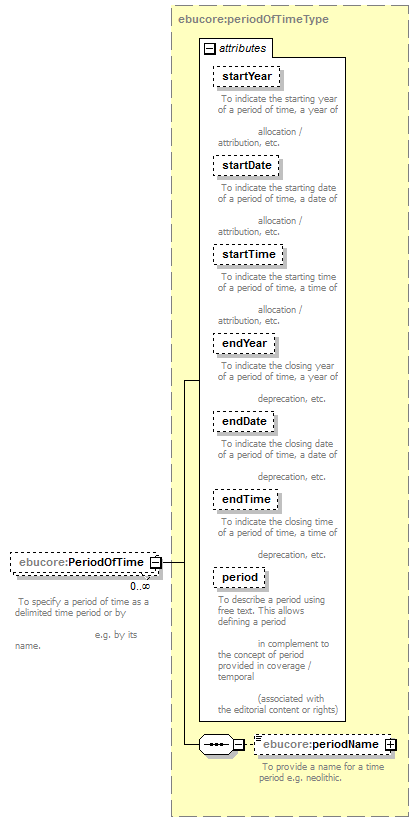| diagram |  |
||||||||||||||||||||||||||||||||||||||||||||||||||||||||||||||
| namespace | urn:ebu:metadata-schema:ebuCore_2014 | ||||||||||||||||||||||||||||||||||||||||||||||||||||||||||||||
| children | ebucore:PeriodOfTime | ||||||||||||||||||||||||||||||||||||||||||||||||||||||||||||||
| used by |
|
||||||||||||||||||||||||||||||||||||||||||||||||||||||||||||||
| attributes |
|
||||||||||||||||||||||||||||||||||||||||||||||||||||||||||||||
| source | <xs:complexType name="temporalType"> <xs:sequence> <xs:element name="PeriodOfTime" type="ebucore:periodOfTimeType" minOccurs="0" maxOccurs="unbounded"> <xs:annotation> <xs:documentation> To specify a period of time as a delimited time period or by e.g. by its name. </xs:documentation> </xs:annotation> </xs:element> </xs:sequence> <xs:attributeGroup ref="ebucore:typeGroup"> <xs:annotation> <xs:documentation> To precise the type of temporal information provided.</xs:documentation> </xs:annotation> </xs:attributeGroup> <xs:attribute name="note" type="string"> <xs:annotation> <xs:documentation> Optional additional contextual information. </xs:documentation> </xs:annotation> </xs:attribute> <xs:attribute name="periodId" type="anyURI"> <xs:annotation> <xs:documentation>An identifier to support the management of time periods (e.g. historical or repetitive event) in databases and RDF. </xs:documentation> </xs:annotation> </xs:attribute> </xs:complexType> |
attribute temporalType/@note
| type | xs:string | ||
| annotation |
|
||
| source | <xs:attribute name="note" type="string"> <xs:annotation> <xs:documentation> Optional additional contextual information. </xs:documentation> </xs:annotation> </xs:attribute> |
attribute temporalType/@periodId
| type | xs:anyURI | ||
| annotation |
|
||
| source | <xs:attribute name="periodId" type="anyURI"> <xs:annotation> <xs:documentation>An identifier to support the management of time periods (e.g. historical or repetitive event) in databases and RDF. </xs:documentation> </xs:annotation> </xs:attribute> |
element temporalType/PeriodOfTime
| diagram |  |
||||||||||||||||||||||||||||||||||||||||||||||||||||||||||||||
| namespace | urn:ebu:metadata-schema:ebuCore_2014 | ||||||||||||||||||||||||||||||||||||||||||||||||||||||||||||||
| type | ebucore:periodOfTimeType | ||||||||||||||||||||||||||||||||||||||||||||||||||||||||||||||
| properties |
|
||||||||||||||||||||||||||||||||||||||||||||||||||||||||||||||
| children | ebucore:periodName | ||||||||||||||||||||||||||||||||||||||||||||||||||||||||||||||
| attributes |
|
||||||||||||||||||||||||||||||||||||||||||||||||||||||||||||||
| annotation |
|
||||||||||||||||||||||||||||||||||||||||||||||||||||||||||||||
| source | <xs:element name="PeriodOfTime" type="ebucore:periodOfTimeType" minOccurs="0" maxOccurs="unbounded"> <xs:annotation> <xs:documentation> To specify a period of time as a delimited time period or by e.g. by its name. </xs:documentation> </xs:annotation> </xs:element> |
XML Schema documentation generated by XMLSpy Schema Editor http://www.altova.com/xmlspy